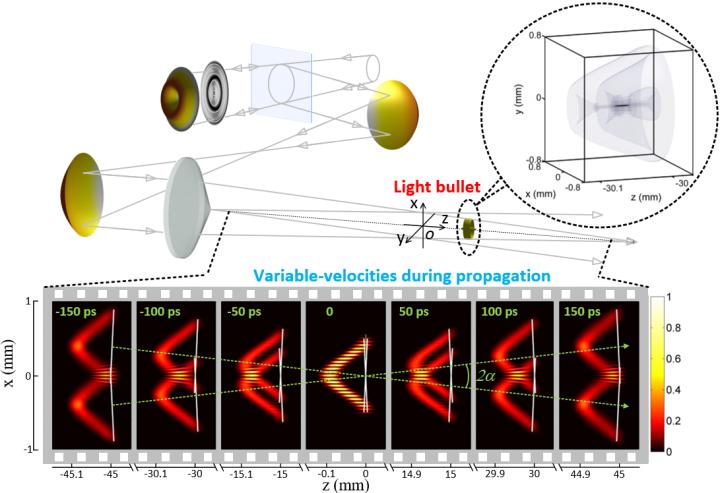Researchers from Osaka University accurately and arbitrarily control flying velocities of light bullets, offering new opportunities for optical and physical applications

Credit: Osaka University
Osaka, Japan — Though it sounds like something straight out of science fiction, controlling the speed of light has in fact been a long-standing challenge for physicists. In a study recently published in Communications Physics, researchers from Osaka University generated light bullets with highly controllable velocities.
According to Albert Einstein’s principle of relativity, the speed of light is constant and cannot be exceeded; however, it is possible to control the group velocity of optical pulses.
Currently, the spatiotemporal coupling of optical pulses provides an opportunity to control the group velocity of three-dimensional non-diffraction optical wave-packets, known as “light bullets,” in free space.
In their previous study (Scientific Reports, DOI: 10.1038/s41598-020-68478-1), this group found that by deforming the pulse-front of optical pulses and keeping the phase-front unchanged, the velocity and the acceleration of the generated flying Bessel-Gaussian (diffraction- and dispersion-free) light bullets can be controlled.
“However, the problem is that only one determined motion form, for example, superluminal or subluminal for velocity and accelerating or decelerating for acceleration, can be achieved in a single propagation path,” explains corresponding author Zhaoyang Li.
In this newly improved method, by using the combination of a deformable mirror and a spatial light modulator, the pulse-front of optical pulses can be arbitrarily deformed, which results in light bullets with arbitrarily-variable velocities (and accelerations) during a single propagation path; e.g., subluminal followed by superluminal and/or accelerating followed by decelerating.
“This non-diffraction light bullet with nearly-programmable flying velocities may bring new opportunities in a wide range of applications, such as free-space communication, bio-imaging, optical detection and processing, particle acceleration and manipulation, radiation generation, among others,” says Zhaoyang Li.
###
The article, “Optical wave-packet with nearly-programmable group velocities,” was published in Communications Physics at DOI: https:/
About Osaka University
Osaka University was founded in 1931 as one of the seven imperial universities of Japan and is now one of Japan’s leading comprehensive universities with a broad disciplinary spectrum. This strength is coupled with a singular drive for innovation that extends throughout the scientific process, from fundamental research to the creation of applied technology with positive economic impacts. Its commitment to innovation has been recognized in Japan and around the world, being named Japan’s most innovative university in 2015 (Reuters 2015 Top 100) and one of the most innovative institutions in the world in 2017 (Innovative Universities and the Nature Index Innovation 2017). Now, Osaka University is leveraging its role as a Designated National University Corporation selected by the Ministry of Education, Culture, Sports, Science and Technology to contribute to innovation for human welfare, sustainable development of society, and social transformation.
Website: https:/
Media Contact
Saori Obayashi
[email protected]
Related Journal Article
http://dx.




